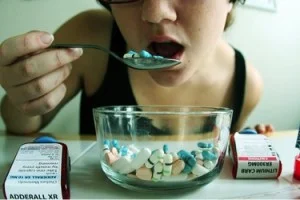By: Diana Elihu
http://www.streetbonersandtvcarnage.com/blog/adderall-doesnt-work/
At universities across America, students are becoming increasingly addicted to a popular prescription drugs, not because they’re trying to get high, but because they hope to get smarter.
The prescription drugs Adderall and Ritalin, which are normally prescribed for children with ADHD (formerly known as ADD), are under heavy abuse by students. Many of the symptoms of ADHD occur from time to time in everyone’s lives, including inattention, hyperactivity, impulsivity, difficulty focusing and frequent conversation shifts to name a few. Any of these actions may occur occasionally in any child and just because a child may show ADHD symptoms frequently does not mean they suffer from it, as other conditions have similar symptoms. Even so, the accessibility of the drug and the perception that it is relatively safe appeals to many students, and UCLA is no exception.
Since the symptoms of ADHD – short attention span, distractibility, and hyperactivity – are easy to feign, many students falsely claim to have ADHD in order to obtain a legal prescription from their physician. While some students have become convinced that Adderall will help them achieve academic success, this notion is purely a myth. Although it’s no secret that the drug can significantly affect one’s academic performance, it by itself does not make an individual smarter. The immediate effects of the drug allow students to concentrate on the task at hand, such as studying for a final or MCAT for long periods of time in complete isolation from trivial noises or stimuli. Adderall works to balance two chemicals in the brain, dopamine and norepinephrine, which allows students to focus better and pull all-nighters.
According to a recent study, which explored the motives for using prescription stimulants among college students, the most commonly reported justification for their illicit use included: to help with concentration (65.2%), to help study (59.8%), to increase alertness (65.2%), to get high (31.0%) and to experiment (29.9%) (Teter, McCabe, LaGrange, Cranford & Boyd, 4). The users of such stimulants fit two different personality types- perfectionists and those seeking to use it for recreational purposes (Low & Gendaszek, 284). This study suggests that students were mostly motivated in some way to perform better in the classroom because they believed Adderall would enhance their immediate, as well as long-term academic performance.
The reliance on prescription stimulants has become almost as commonplace as drinking Red Bull and caffeine, which use to be the customary methods for studying. Alarmingly a number of students who admitted to misusing these stimulants reported that they “were not concerned with the misuse and abuse of prescription stimulants, and a number of students felt they should be more readily available…Also other students have anecdotally reported stockpiling medication and taking a higher dose than prescribed in preparation for an exam or while writing a paper” (White, Becker-Blease & Grace-Bishop, 265). This lack of appreciation of the health risks associated with self-medicating sheds light on an ongoing and heated debate among students.
Analogous to how steroids are barred from use in professional sports, the exploitation of Adderall among college students raises issues of competitiveness and fairness. Is the use of this “study drug” considered cheating? Among those who refuse to dabble in these study drugs, the disapproval and bitterness can be high. Students who decline to partake rightly complain that by not taking them, they are at a disadvantage to everyone else, especially if students are being graded on a bell-curve. However, students who seek out these stimulants argue that the stresses of the current economic downturn, the tightening job market, and the fierce competition to get into grad-schools further compels them to seek short cuts to alleviate this Herculean pressure on their backs. While some report that it is wrong to use the drug for any reason outside of a prescription, others justify it by claiming that “I’m doing it for the right reasons” (DeSantis & Hane, 35). Students rationalize that because they are acting to promote a positive outcome, like improving their grades, their use is morally correct. Thus, the culture at schools with high academic expectations of their students, such as at UCLA, creates a competitive environment that pushes students to seek out these little orange tablets. Rather, colleges need to focus on restoring the practice of education and learning for the sake of learning, rather than for grades. This change could then also decrease the number of students running to their professors’ office hours to argue for a higher grade or for more points on every problem in the hopes that the points would add up.
Given the effectiveness of prescription stimulants, clinicians who prescribe such drugs carry a heavy burden on their shoulders. The difficult task of balancing the medical necessity of drugs with their possible non-medical use reflects the greater call for more education aimed at preventing and reducing illicit behavior among students (McCabe, Knight, Teter, & Wechsler, 104). Although most agree that policies should be in place to deter students from partaking in this kind of activity, they offer no probable suggestions as to what these policies might be. As students are the future doctors, entrepreneurs, lawyers, etc. of our society, the abuse of prescription stimulants to cut corners and get ahead in school does not bode well. The ingredients for academic success are no longer going to class and studying long hours in the library, but rather on the steady flow of prescription stimulants.